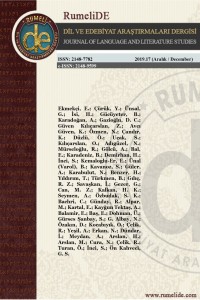Abstract
In the book titled Woman Without a grave of Assia Djebar, which is the subject of our study, the narrator tells the story of an Algerian women Suleyha - also her own neighbour - who established a network of resistance against French sovereignty. The narrator presents to the reader the history narrated between reality and fiction. The author, who is the utterer of the enunciation undertake the enunciation and she also hand the narration to the protagonist Süleyha and other women who lived with her. This triple axis formed by the complex structure of the autobiography / life story / fiction unveil different subjects in different enunciation levels. When the author, who is the actual subject of the work, assigns others subjects to assume the narration, the reader enters into the meaning universe of every different woman who takes over the history and says “I”. As the identities of the “I” change, the identity of the “other” changes and the balance of the spheres of existence changes. Both the visual, auditory and literary art texts, the semiotic methods and enunciation theory studies that enable us to reach the possibilities of meaning offered by the work, the studies on the subject, which has brought us today, constitute the methodological basis of this study, which consists of the subjects we encounter in every layer of the sentence. In our study, we aim to examine this altered structure that emerges in the superficial and deep structure of the narrative by putting polyphony notion and the subject at the centre. Therefore, in the light of the polyphony principle and the work of these theories, we aim to reveal the changeable structure of different subjects that emerge in different layers of the work. Afterwards, we aim to shed light on the observations that the subjects have a common meaning field from different meaning fields as the narrative progresses by revealing the figurative/thematic roles of these subjects taking on discourse in different layers.
Keywords
References
- Benveniste, E. (1995). Genel Dilbilim Sorunları. (Çev: Erdim Öztokat). İstanbul: YKY. Courtés, J. (2007). La sémiotique du langage. Paris: Armand Colin. Djebar, A. (2013). Mezarı Olmayan Kadın. (Çev. Olcay Geridönmez) İstanbul: Evrensel Basım Yayın. Lejeune, P. (1996) Le Pacte autobiographique. Paris: Éditions du Seuil Lejeune, P. (1980). Je est un autre, L'autobiographie de la littérature aux médias. Paris: Éditions du Seuil. Yücel, T. Et al. (2001) Göstergebilim Tartışmaları. İstanbul: Multilingual. Öztokat, N. (2005). Yazınsal Metin Çözümlemesinde Kuramsal Yaklaşımlar. İstanbul: Multilingual.
Abstract
Bu çalışmaya konu olan Assia Djebar’ın Mezarı Olmayan Kadın adlı yapıtında Fransız egemenliğine karşı bir direniş ağı kuran ve kendisinin de eski komşusu olan Cezayirli Süleyha’nın öyküsü anlatılmaktadır. Söylemi üstlenen anlatıcı hem kendi çocukluk anılarına hem de bölgenin tarihsel olaylarına değinerek gerçekle kurgu arasındaki anlatısını okura sunmaktadır. Yapıtın özyaşam öyküsü / yaşam öyküsü / anlatı üçlü ekseninde gidip gelen karmaşık yapısında sözceleyen özne olan yazar kimi zaman anlatıyı üstlenmekte, kimi zaman ise anlatının başkahramanı olan Süleyha’ya ve onunla birlikte yaşamış olan başka kadınlara sözü vermektedir. Yapıtın asıl sözceleyen öznesi olan yazarın hem Süleyha’ya hem de diğer kadınlara söz vermesiyle okur, sözcelemi üstlenen ve “ben” diyen her farklı kadının anlam evrenine girmiş olmaktadır. “Ben”lerin kimlikleri değiştikçe “öteki’nin de kimliği değişime uğramakta ve varlık alanlarının dengeleri değişmektedir. Gerek görsel, gerek işitsel gerekse yazınsal sanat metinlerinde yapıtın sunduğu anlam olanaklarına ulaşmamızı sağlayan göstergebilimsel yöntem ve sözcelem kuramı çalışmalarının bizi bugün getirdiği nokta olan özne üzerine yapılan çalışmalar, sözcelemin her katmanında karşımıza çıkan öznelerden oluşan bütüncemizi ele aldığımız bu çalışmanın da yöntemsel temelini oluşturmaktadır. İncelememizde anlatının yüzeysel ve derin yapısında ortaya çıkan bu değişmeceli yapıyı çoksesliliği ve özneyi merkeze koyarak incelemeyi amaçlamaktayız. Dolayısıyla birden fazla türü ve dolayısıyla birden fazla özneyi içinde barındıran bu yapıtı çokseslilik ilkesi ışığında ve söz konusu kuramların çalışma alanı olan “ben” kavramı üzerinden ilerleterek yapıtın farklı sözceleme katmanlarında ortaya çıkan farklı öznelerin değişmeceli yapısını ortaya koymayı amaçlamaktayız. Sonrasında ise farklı katmanlarda söylemi üstlenen bu öznelerin izleksel/betisel rollerini ortaya çıkararak öznelerin anlatı ilerledikçe farklı anlam alanlarından ortak bir anlam alanına sahip olduğu izlencelerine ışık tutmayı amaçlamaktayız.
Keywords
References
- Benveniste, E. (1995). Genel Dilbilim Sorunları. (Çev: Erdim Öztokat). İstanbul: YKY. Courtés, J. (2007). La sémiotique du langage. Paris: Armand Colin. Djebar, A. (2013). Mezarı Olmayan Kadın. (Çev. Olcay Geridönmez) İstanbul: Evrensel Basım Yayın. Lejeune, P. (1996) Le Pacte autobiographique. Paris: Éditions du Seuil Lejeune, P. (1980). Je est un autre, L'autobiographie de la littérature aux médias. Paris: Éditions du Seuil. Yücel, T. Et al. (2001) Göstergebilim Tartışmaları. İstanbul: Multilingual. Öztokat, N. (2005). Yazınsal Metin Çözümlemesinde Kuramsal Yaklaşımlar. İstanbul: Multilingual.
Details
| Primary Language | Turkish |
|---|---|
| Subjects | Creative Arts and Writing |
| Journal Section | Turkish language, culture and literature |
| Authors | |
| Publication Date | December 21, 2019 |
| Published in Issue | Year 2019 Issue: 17 |


